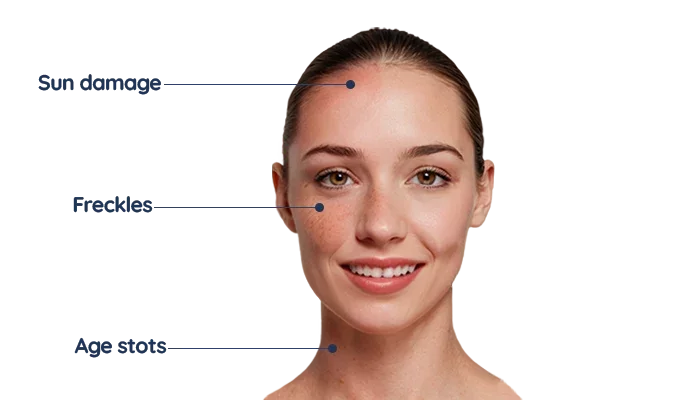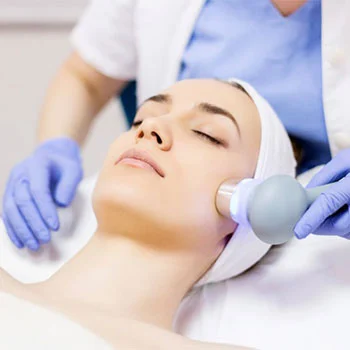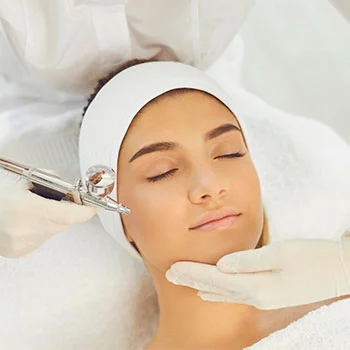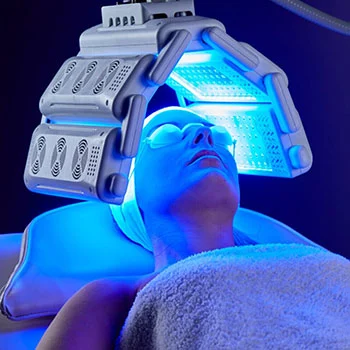What is photorejuvenation?
Photorejuvenation, also known as photofacial or IPL (Intense Pulsed Light) therapy, is a non-invasive skin treatment that uses light-based technology to improve skin tone, texture, and appearance. This cosmetic procedure targets various skin issues such as sun damage, age spots, freckles, redness, and uneven pigmentation.
Photorejuvenation works by delivering pulses of light energy into the skin, which are absorbed by pigmented cells or blood vessels, stimulating collagen production, and promoting skin regeneration. The treatment helps to reduce signs of aging, sun damage, and skin imperfections, resulting in smoother, clearer, and more youthful-looking skin. Photorejuvenation is a popular option for those seeking to enhance their skin's overall health and appearance without the need for surgery or downtime.
What concerns can be addressed by photorejuvenation?
IPL photofacial is used to enhance skin health, address various skin concerns, and promote a more youthful and revitalized complexion without the need for invasive procedures. Photorejuvenation can address various skin concerns, including:
- Sun damage: Photorejuvenation can help reduce sunspots, sun damage, and hyperpigmentation caused by UV exposure.
- Age spots and freckles: It can target and lighten age spots, freckles, and other pigmentation irregularities.
- Redness and rosacea: IPL photofacial can reduce redness, flushing, and symptoms of rosacea.
- Uneven skin tone: The procedure can improve overall skin tone and texture, creating a more even complexion.
- Fine lines and wrinkles: Photorejuvenation stimulates collagen production, which can help reduce the appearance of fine lines and wrinkles.
- Acne scars: It can help diminish the appearance of acne scars and improve skin texture.
- Enlarged pores: Photorejuvenation can minimize the appearance of enlarged pores, giving the skin a smoother look.
- Blood vessels: IPL photorejuvenation can target and reduce visible blood vessels and vascular lesions on the skin.
Photorejuvenation is a versatile treatment that can address multiple skin concerns, leading to a more youthful, radiant complexion.
How it works
IPL therapy works by utilizing specific wavelengths of light energy to target different chromophores in the skin, such as melanin (pigment) or hemoglobin (blood vessels). During the treatment, the light energy is absorbed by these chromophores, leading to various therapeutic effects.
In the case of pigmented lesions like sunspots or age spots, the light energy is absorbed by melanin, causing the pigment to break down and fade over time. The light energy can also penetrate the deeper layers of the skin, stimulating fibroblast cells to produce more collagen and elastin. This process helps improve skin firmness, elasticity, and texture, reducing the appearance of fine lines and wrinkles. For issues like redness or visible blood vessels, the light energy can target hemoglobin in the blood vessels. This can lead to the constriction of blood vessels and a reduction in redness and vascular lesions.
The specific settings and parameters of the light energy used in photorejuvenation can be customized based on individual skin concerns and desired outcomes, making it a versatile and effective treatment for a wide range of skin conditions.
Am I a good candidate for IPL photofacial?
You may be a good candidate for an IPL photofacial or photorejuvenation if you have one of the skin concerns mentioned above and wish to improve the appearance of your skin. However, some individuals may not be suitable candidates for IPL photofacial treatment. These may include:
- Pregnant women: Pregnant women are generally advised to avoid IPL treatments due to the potential risks involved.
- History of keloid scarring: Individuals with a history of keloid scarring may not be suitable candidates for IPL photofacials, as the treatment could potentially trigger further scarring.
- Recent sun exposure: Those with recent sun exposure or tanned skin may not be suitable candidates for IPL treatment, as it can increase the risk of adverse effects such as burns or hyperpigmentation.
- Active skin infections: Individuals with active skin infections, such as cold sores, eczema, or psoriasis, may need to wait until the infection has cleared before undergoing IPL photorejuvenation.
- Use of certain medications: Some medications, such as photosensitizing drugs or acne medications like isotretinoin, can make individuals more sensitive to light-based treatments like IPL. In such cases, it may not be advisable to undergo IPL photofacial treatment.
- Dark skin tones: IPL therapy may not be suitable for individuals with darker skin tones, as they can be at a higher risk of experiencing pigmentation changes or burns.
It is important to consult with a skincare professional or dermatologist to assess your individual skin type, concerns, and medical history to determine if photorejuvenation treatment is safe and suitable for you.
How to prepare for the procedure
To prepare for a photorejuvenation procedure, consider the following steps:
- Consultation: Schedule a consultation with a skincare professional or dermatologist to discuss your skin concerns, medical history, and treatment goals. They will assess your skin condition and determine if photorejuvenation is suitable for you.
- Sun protection: Avoid direct sun exposure and tanning beds for several weeks before the procedure. Use sunscreen daily and wear protective clothing to prevent sun damage.
- Skincare routine: Follow any pre-treatment skincare recommendations provided by your skincare professional. This may include avoiding certain products or treatments that can make your skin more sensitive.
- Discontinue certain medications: Inform your skincare professional about any medications you are taking, as some medications can increase photosensitivity. They may advise you to temporarily stop using certain medications before the procedure.
- Avoid certain procedures: Refrain from waxing, chemical peels, or other skin treatments that may irritate the skin in the weeks leading up to the IPL photofacial procedure.
- Hydration: Keep your skin well-hydrated by drinking plenty of water and using moisturizers to maintain skin health and improve treatment outcomes.
- Shave treatment area: If hair is present in the treatment area, you may be advised to shave it before the procedure to ensure optimal light penetration.
By following these preparation steps, you can help ensure the best possible results from your photorejuvenation procedure and minimize the risk of complications.
How it’s done
The IPL photo facial procedure typically involves the following steps:
- Consultation: Your skincare professional will assess your skin concerns, discuss your treatment goals, and determine if photorejuvenation is suitable for you.
- Skin preparation: The treatment area will be cleansed, and a cooling gel may be applied to enhance light penetration and protect the skin.
- Eye protection: You will be provided with protective eyewear to shield your eyes from the intense light during the procedure.
- Light pulses: The skincare professional will use a handheld device that emits pulses of light over the treatment area. The light energy is absorbed by specific targets in the skin, such as pigment or blood vessels.
- Sensation: You may feel a mild snapping or warming sensation as the light pulses are delivered to the skin. Some discomfort is possible, but most individuals tolerate the treatment well.
- Repeat passes: Multiple passes with the light-emitting device may be performed to ensure thorough treatment of the targeted areas.
Post-treatment care: After the procedure, any gel or residue will be removed from your skin. Your skincare professional may apply soothing creams or recommend skincare products to help with healing and skin recovery.
The duration of the procedure can vary depending on the size of the treatment area and the specific skin concerns being addressed. Multiple sessions may be recommended for optimal results, spaced several weeks apart.
After the procedure
After a photorejuvenation procedure, you may experience some common effects and will need to follow post-treatment care instructions to ensure optimal results. Here are some typical post-procedure guidelines:
Redness and swelling: It is normal to experience mild redness and swelling in the treated area, which usually subsides within a few hours to a few days. Applying cool compresses or soothing creams recommended by your skincare professional can help alleviate these symptoms.
- Sun protection: Protect your skin from sun exposure by wearing sunscreen with a high SPF and avoiding direct sunlight. Sun protection is crucial to prevent sun damage and maintain the results of the treatment.
- Avoid irritants: Avoid using harsh skincare products, exfoliants, or treatments that may irritate the skin. Stick to gentle skincare products recommended by your skincare professional to support skin healing.
- Moisturize: Keep your skin well-moisturized to promote healing and maintain skin hydration. Hydrated skin can recover more effectively from the treatment.
- Avoid heat: Refrain from activities that generate heat, such as hot showers, saunas, or intense exercise, as they can exacerbate redness and swelling in the treated area.
- Follow-up sessions: Depending on your skin concerns and treatment plan, you may need multiple sessions of IPL photorejuvenation to achieve optimal results. Follow your skincare professional's recommendations for the frequency of treatments.
- Skincare routine: Maintain a consistent skincare routine with gentle products that support skin healing and regeneration. Your skincare professional may recommend specific products tailored to your skin type and concerns.
- Follow-up appointment: Schedule a follow-up appointment with your skincare professional to assess the results of the treatment, address any concerns, and plan for future sessions or additional skincare treatments if needed.
By following these post-treatment care instructions and guidelines, you can help ensure a smooth recovery, minimize potential side effects, and maximize the benefits of your photorejuvenation procedure.
Potential risks and side effects of IPL therapy
IPL Photorejuvenation is generally considered a safe cosmetic procedure, but like any treatment, it carries potential risks and side effects. Some common risks and side effects associated with IPL photofacial include:
- Pain or discomfort: Some individuals may experience mild pain, discomfort, or a stinging sensation during the treatment, which is usually temporary and tolerable.
- Redness and swelling: After the procedure, it is common to experience temporary redness, swelling, or mild bruising in the treated area. These effects typically subside within a few hours to a few days.
- Skin sensitivity: Your skin may be more sensitive to touch or sunlight following the treatment. It is essential to protect your skin from sun exposure and avoid irritants to prevent further irritation.
- Pigment changes: In some cases, photorejuvenation can cause temporary hyperpigmentation (darkening) or hypopigmentation (lightening) of the skin. These changes are usually temporary but may be more common in individuals with darker skin tones.
- Blistering or crusting: Rarely, blistering or crusting may occur in the treated area, especially if the skin is not adequately protected or if the treatment parameters are too aggressive. Proper post-treatment care can help prevent these issues.
- Risk of burns: In rare cases, excessive heat or energy from the light-based device can lead to burns on the skin. This risk is minimized by using appropriate settings and techniques during the procedure.
- Scarring: Although uncommon, there is a slight risk of scarring, especially in individuals with a history of keloid scarring or poor wound healing. Proper aftercare and following post-treatment instructions can help reduce this risk.
- Eye injury: Without proper eye protection, there is a risk of eye injury from the intense light emitted during the procedure. Protective eyewear should always be worn to shield the eyes from the light.
It is essential to discuss potential risks and side effects with your skincare professional before undergoing IPL treatment. By choosing a qualified and experienced provider, following pre- and post-treatment instructions, and communicating any concerns during the process, you can help minimize the risks and achieve safe and effective results from photorejuvenation.
How much does IPL photofacial cost?
The cost of a photorejuvenation treatment can vary depending on various factors, including the location of the clinic, the expertise of the skincare professional, the size of the treatment area, the number of sessions required, and any additional services or customized treatment plans. On average, the cost of a single IPL photofacial session can range from $100 to $600 per session.
It is important to note that multiple sessions are often recommended to achieve optimal results, and package deals or discounted rates may be offered for purchasing multiple sessions upfront. Additionally, some clinics may offer financing options or payment plans to make the treatment more affordable for patients.
To determine the exact cost of an IPL photorejuvenation treatment for your specific needs and goals, it is recommended to schedule a consultation with a skincare professional or dermatologist. During the consultation, they can assess your skin concerns, develop a personalized treatment plan, and provide you with a more accurate cost estimate based on your individual requirements.
FAQs
Is IPL the same as photorejuvenation?
IPL therapy is a more general term encompassing a range of broad light wavelengths employed in various cosmetic treatments, including hair removal, tattoo removal, and enhancing skin vitality. When employed for addressing skin issues like aging signs, pigmentation, and acne, it is known as photorejuvenation or photofacial, aiming to rejuvenate and revitalize the skin.
How many sessions of photorejuvenation do I need?
The number of sessions needed for IPL therapy can vary depending on your skin concerns, treatment goals, and the condition of your skin. Typically, a series of 3 to 5 sessions spaced several weeks apart is recommended to achieve optimal results.
How long do the results from IPL photofacial last?
The results of an IPL photofacial can last for several months to a year, depending on factors such as sun exposure, skincare routine, and individual skin characteristics. Maintenance treatments may be recommended to sustain the results over time.
Does photorejuvenation hurt?
IPL therapy is generally well-tolerated by most individuals and may cause mild discomfort or a warming sensation during the procedure. Topical numbing creams can be applied to minimize any discomfort.
How long does an IPL photofacial treatment take?
An IPL photofacial treatment typically takes about 20 to 30 minutes, depending on the size of the treatment area and the specific settings used during the procedure.
How soon after photorejuvenation will I see the results?
You may start to see improvements in your skin texture, tone, and appearance within a few weeks after your first session of IPL photorejuvenation. Full results are usually noticeable after completing a series of treatments.
What are the most common target areas of IPL therapy?
The most common target areas for IPL therapy include the face, neck, chest, hands, and areas with sun damage, pigmentation issues, redness, or visible blood vessels.
Can I wear makeup after IPL photofacial?
It is recommended to avoid wearing makeup immediately after an IPL photofacial to allow your skin to heal properly.
Does IPL therapy really work?
IPL therapy is an effective treatment for various skin concerns, including sun damage, age spots, freckles, redness, and uneven pigmentation. When performed by a skilled professional and coupled with proper pre- and post-treatment care, IPL therapy can deliver noticeable improvements in skin texture and appearance.
Is IPL approved by the FDA?
Yes, Intense Pulsed Light (IPL) devices used for cosmetic procedures, including photorejuvenation treatments, are approved by the U.S. Food and Drug Administration (FDA) for specific indications. IPL devices have received FDA clearance for various skin treatments, such as the treatment of sun damage, age spots, pigmentation issues, and vascular lesions.




